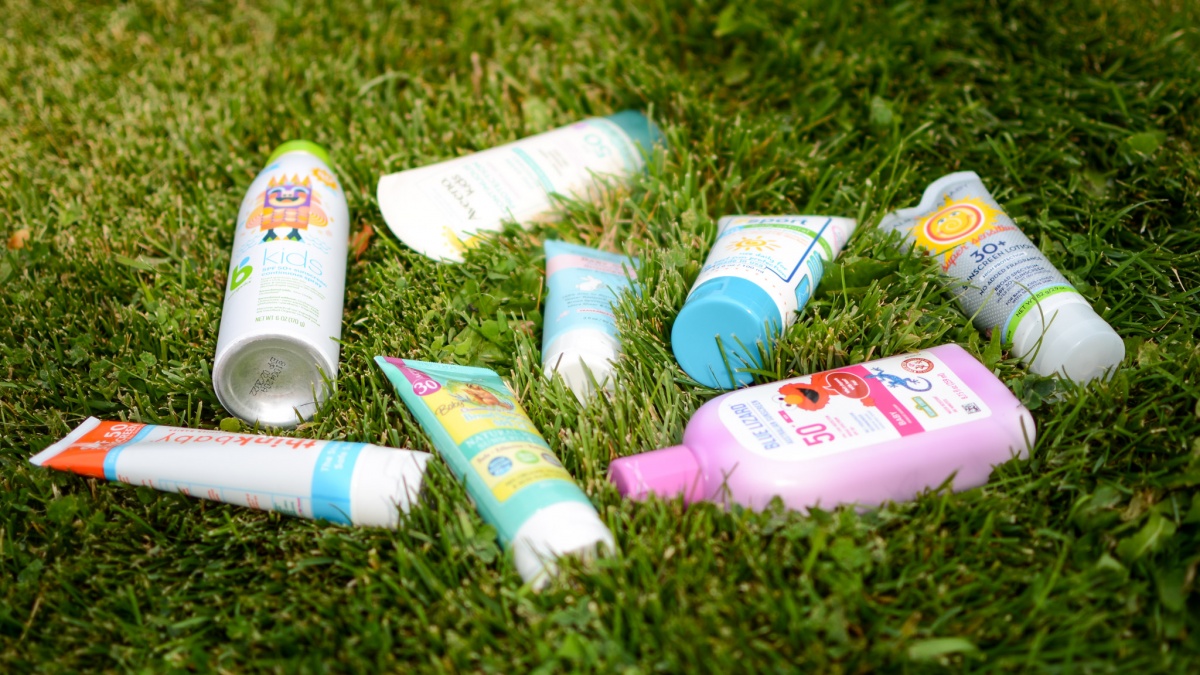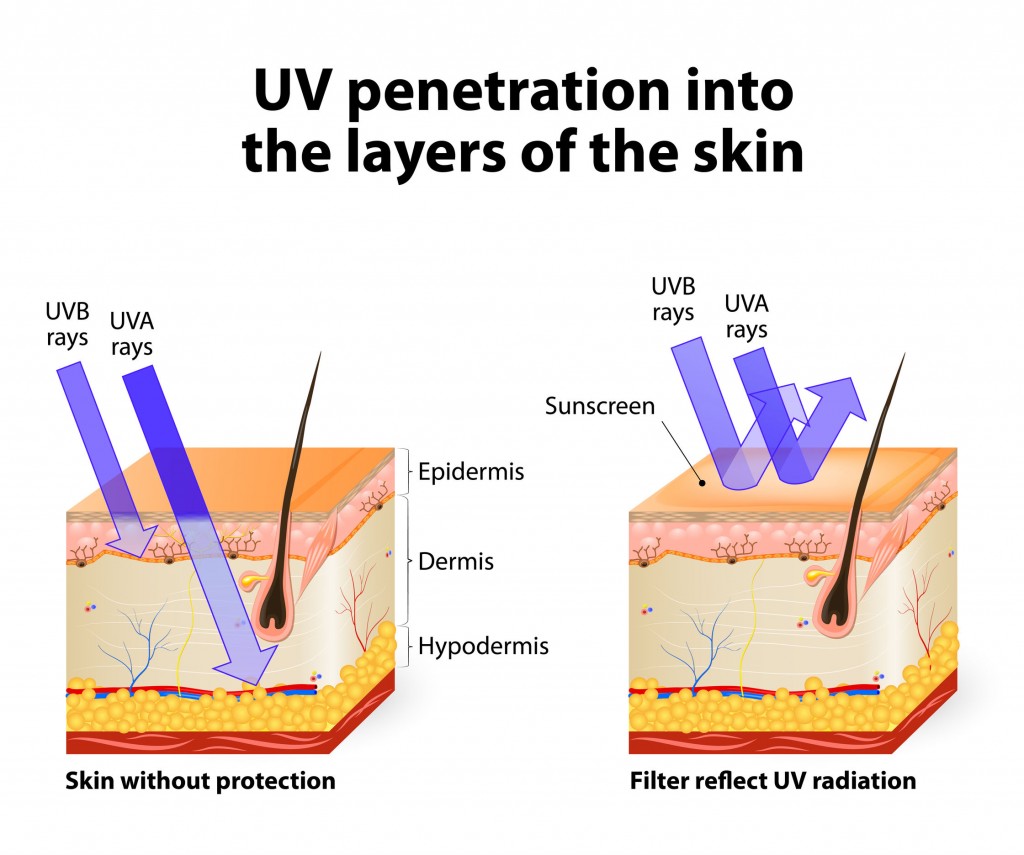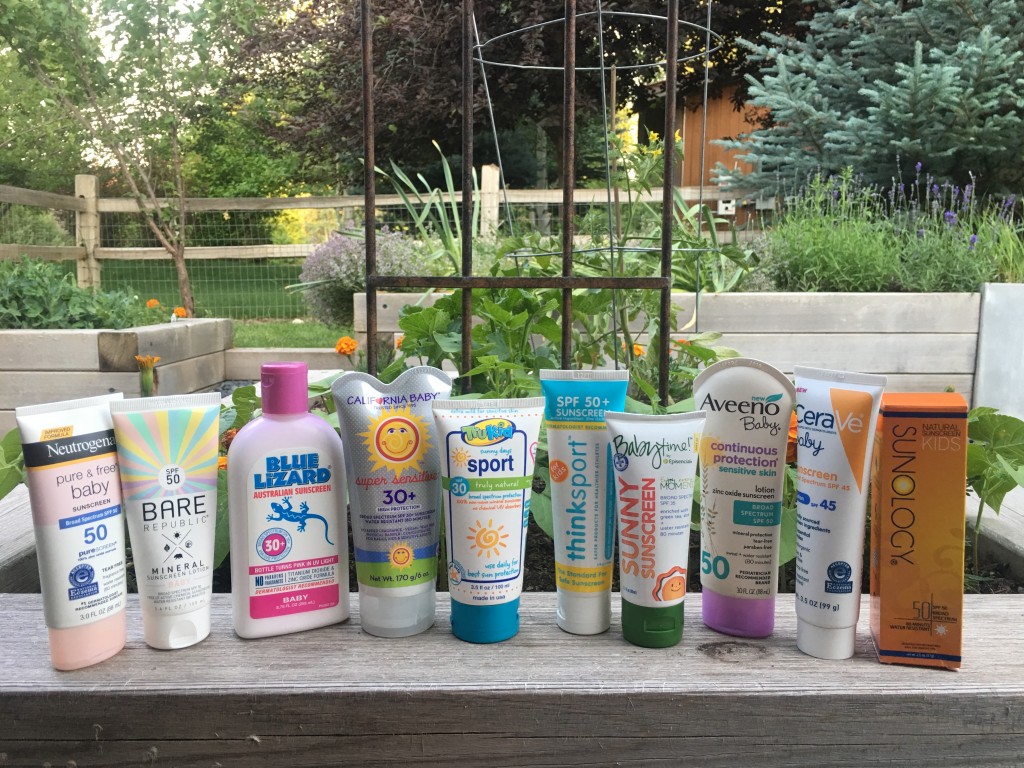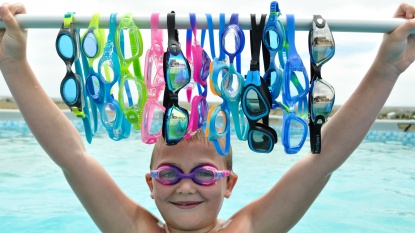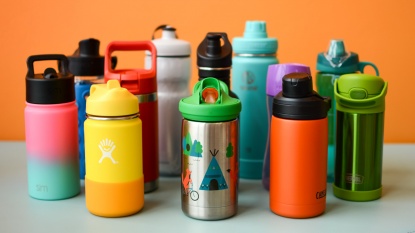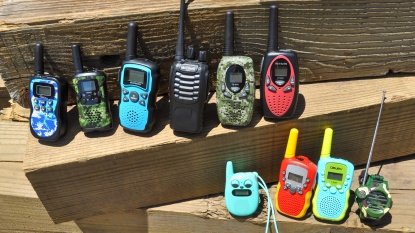Although products are always changing, one thing will not: the need for complete sun protection, especially during the summertime when outdoor activity abounds. Before we delve into screening basics, let's dig deep into the sun and practical protective tips.
A Trifecta of Sun Facts
To understand why protecting your skin is so important, you need to know more about the sun, particularly UVA and UVB rays.
- The Difference Between UVA and UVB Rays — Ultraviolet radiation travels from the sun, enters the atmosphere, and reaches us on Earth through UVA rays (long-wave, 320 to 400 nm) and UVB rays (shortwave, 290 to 320 nm). Interestingly, there are also even shorter UVC rays; however, the ozone layer absorbs these. Both UVA and UVB radiation contribute to skin aging and cancers (melanoma, basal cell carcinoma, and squamous cell carcinoma), eye damage (cataracts, macular degeneration), and eye cancer (melanoma). UVA and UVB radiation both cause tanning, but only UVB causes sunburn. So, just because you don't sunburn, it doesn't mean that your skin has had a good day if left unprotected. The other fascinating difference about UVA is that it penetrates deeper through the skin than UVB. UVA affects keratinocytes, the origin of basal and squamous cell carcinomas. The peak hours of UVB rays are from 10 am to 4 pm, whereas UVA is present during all daylight hours and penetrates through glass windows, unlike UVB. Collectively these factors mean that sun protection is essential during all daylight hours, even when driving.
- Cloudy Skies Doesn't Give You a Hall Pass on Sunscreen — Fact. UVA radiation penetrates through clouds and can even reach you when you hide in the shade. This fact is a bummer because, let's face it, who doesn't love a hall pass? So, even though you may not feel the effects of the sun on a cloudy day, UVA rays can still penetrate through to the dermal layer of your skin, cumulatively increasing your risk of developing skin cancer over time. Day after day, and year after year, this chronic exposure to UVA adds up and matters. The take-away? Use sunscreen. Every day. Rain or shine. Clouds or snow. Warm or cold.
- Ultraviolet Radiation Affects the Eyes — Although we've already said it, we want to highlight it again because it is that important. UV radiation affects us beyond our skin. It can damage your eyes, presenting later in life as macular degeneration, cataracts, and occasionally retinal melanoma. Thus, wearing UV protective sunglasses is essential to protect vision and long-term eye health.
A Triple Defense is the Best Offense
Below is the triple defense of lifestyle strategies to protect yourself and your family from the sun's harmful effects. Consider them a year-round mantra for your family whenever you enjoy the great outdoors.
- Avoid Peak Exposure — Plan outdoor activities around peak sun exposure (10 am to 4 pm is the high-risk window).
- Slather Up — Apply lotion with an SPF of 30 or higher to any exposed skin 15 to 30 minutes BEFORE outdoor activity or swimming, in all kinds of weather, even if you utilize shade. Be sure to use plenty and frequently reapply, especially after water exposure or towel drying. If you stay in the shade, you must lotion up. For example, if you sit under a well-shaded umbrella at the beach, you are still exposed to reflective UV rays from sand and water, leaving you susceptible to sunburn. Always store bottles away from heat and direct sunlight when possible to maintain a formula's effectiveness.
- Cover-Up — To maximize skin protection, cover up with a hat, sunglasses, and SPF clothing like a loose and light long sleeve shirt with a hood and pants. For example, a dry white t-shirt has an SPF rating of 7. However, when wet, the SPF decreases to 3. For swimming babies and toddlers, full-coverage swimsuits and shirts can provide peace of mind. Also, find shade or bring it with you in the form of a pop-up tent or umbrella.
Mineral-Based Products
Mineral-based and chemical-based formulas function differently and in user experience. The active mineral ingredients, such as zinc oxide and titanium dioxide, remain on top of the skin, acting as a physical blocker and scattering the sun's rays. They are thick, and despite best efforts to rub in, a whitish hue usually remains as they do not absorb into the skin. Once applied, they can be greasy or chalky, but they work great and are healthier for children. Interestingly, the creation of "invisible zinc," or small nanoparticles that are smaller, lighter, and more manageable to blend, produces a less white final appearance. Since some mineral formulations can separate somewhat in the container, they require a good shaking before application to ensure that the active ingredient is part of the application. When significant separation occurs and shaking doesn't resolve the issue, it is time to buy a new container.
The Skinny on Non-Nano Zinc OxideMany zinc oxide containing products now list "non-nano zinc oxide" as a point of pride. This claim means that the Zinc active ingredient is larger than 100 microns in size. The assumption is that a particle of this size can't penetrate the skin's barrier and won't absorb into the bloodstream. Does this matter, or is it marketing hype? While the answer is steeped in controversy, the reality is that titanium dioxide, another active ingredient in many mineral-based options, is a nanoparticle and has shown to be not small enough to penetrate the skin's barrier. Furthermore, both zinc oxide and titanium dioxide are inert substances, meaning they are chemically inactive. They are also photostable, meaning that the chemical composition doesn't change with exposure to UV radiation. The bottom line is zinc oxide, whether nano or non-nano (as well as titanium dioxide), are safe for use with children.
Chemical-Based Formulations
Chemically based products use a blend of active ingredients, such as avobenzone, homosalate, octisalate, and others. These products protect by absorbing into the skin. These products are thinner and easier to apply. Nonetheless, this type can be irritating to a baby or child's skin resulting in uncomfortable burning, redness, rash, or dryness. Even adults with sensitive skin can develop allergic-type reactions and rashes to active chemical ingredients (oxybenzone being the main culprit) and have better luck with mineral-based ones. That said, some adults have success with avobenzone as an effective and less irritating ingredient that offers good UVA protection. Also, these chemicals can be absorbed into the skin and are known endocrine disrupters that can cause potential health problems.
Q & A: Sun Combating Lotions 101
The following information helps answer common questions about general sunscreen use, label reading, and selection. So, the next time you face a variety of lotions, instead of bursting out in a cold sweat, you can feel confident about your choice.
- What Age is it Safe to Use Sunscreen on a Baby? — The American Academy of Pediatrics (AAP) recommends keeping babies under 6-months-of-age entirely out of the sun due to skin thinness and sensitivity. However, if this is unavoidable, we suggest covering their skin as much as possible and use mineral-based protection on exposed areas, even if they are wearing a hat. After 6-months, you should routinely use a mineral-based product when your baby is outside.
- What is the Best Type: Lotion, Stick, or Spray? — Hands down, LOTION! Lotion allows you to control the quantity easily. You should always use a thick layer. We don't recommend stick-based protection as it can be challenging to get full coverage or a thick enough layer, which can result in unintentional sunburns. However, sticks can be useful for spot application for hard-to-reach areas; make sure to apply a thick, complete layer. Our real pet peeve is with aerosolized spray bottles. When deployed, it can transmit a finely aerosolized mist downwind to innocent bystanders. It reminds us of secondhand smoke, as it is so noxious, and we prefer not to use aerosolized products. But, we understand why people use sprays. They are easy to use, hands don't get greasy, and they get the job done, right? To our knowledge, a complete analysis of the inhalation of aerosolized particulates is not available. Still, common sense indicates that it is not a good thing, particularly for anyone that suffers from allergies and asthma, as well as young or impaired respiratory systems. Finally, sprays are lacking as most folks don't rub them onto the skin once applied, making them less useful as it often results in inadequate coverage and/or product retention. Also, many sprays are clear, so it is challenging to determine coverage adequacy. The possible outcome? Sunburn city.
In our research, we discovered incidents of the use of aerosolized sunscreen resulting in fire burns. Skin covered in wet sunscreen has started on fire after exposure to a fire source. Unfortunately, bottles do not adequately label this potential issue. Known incidents occurred near a heated BBQ, citronella candle, and cigarette lighter. While the reports are limited and potentially rare, we believe this is another reason to avoid aerosolized products, especially for children.
- Do I Need to Pay Attention to Water-Resistance? — ABSOLUTELY! If a formulation label has water resistance guidelines, follow them! Most have 80-minute water resistance, but occasionally, one with 40-minute resistance pops up, and paying attention can make a significant difference on whether or not your little one gets burned. No one wants to reapply lotion every 40-minutes! Nonetheless, reapplication is necessary after sweating OR swimming for the resistance window duration. Reapplication is also essential after towel-drying, which can inadvertently remove the lotion. If neither swimming nor sweating, reapplication should occur every 2 hours, and pay special attention to areas where rubbing can occur, like the upper arms when wearing a life vest.
- When Do I Need to Replace My Sunscreen? — When the product is past its expiration date, has become clumpy or separated, or smells strange, it is time to toss it. We know that throwing out a non-empty bottle is painful, but this isn't a good time to cut corners. You can find the expiration date on the corrugated edge or the bottom of a tube/bottle.
- Which Level of SPF to Use? — SPF stands for Sun Protection Factor, a measure of UVB protection. The SPF sweet spot is between 30 to 50. To illustrate this, consider the following, an SPF of 15 blocks 93% of UVB. An SFP of 30 blocks 97% of UVB. And, an SPF 50 blocks 98% of UVB's rays. Simply put, past an SPF of 30, there are diminishing returns in protection.
- What About UVA Protection? — SPF correlates to UVB blockage, so for adequate UVA protection, you need to use a broad-spectrum formula, meaning one that provides sufficient coverage from UVA and UVB Rays. This need is where label reading is vital. For optimal UVA protection, it is essential to have at least one or a combination of the following active ingredients, zinc oxide (mineral), titanium dioxide (mineral), avobenzone (chemical), ecamsule (chemical), or oxybenzone (chemical). For mineral-based formulations (those we prefer and recommended here), having zinc oxide, titanium dioxide, or a combination will work for full-spectrum protection.
- Should I Use a Combination Sunscreen/Insect Repellant? — Our advice? Just Say No. Why? They aren't as effective and typically use chemical-based active ingredients. Also, sunscreen requires more frequent applications than repellants. This big disconnect feels unnecessary and exposes little ones to higher concentrations of chemicals than are necessary.
- Does the Type of Active Ingredients Matter? — In our opinion, the ingredients matter, especially when choosing for children. Sunscreen's active ingredients include mineral, chemical, or a combination. Paying attention to details is vital to your overall pick, particularly for sensitive skin and developing babies.
Conclusion
Regarding little ones, we believe a mineral-based sunscreen in a lotion formulation is the best choice. Although it can take some elbow grease to apply and tends to leave a white residue, we do like that it remains on the skin instead of being absorbed into the skin. If mineral-based products are cost-prohibitive, the chemical-based formulation is far better than skipping sunscreen protection. We really can't stress this enough. Also, since there are typically several active and inactive ingredients in any product, we recommend doing a spot test with any new product to determine skin sensitivity. As always, remember to practice triple defense to maximize sun protection. Such as covering up with a hat, sunglasses, long-sleeved shirts, pants, and protective lip balm.

